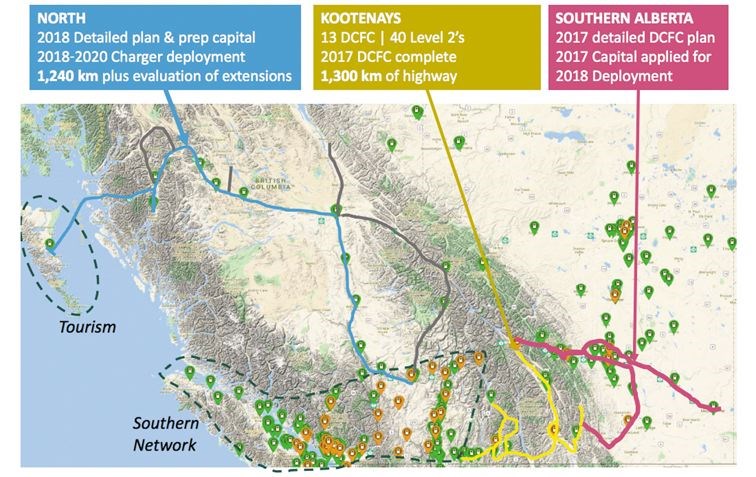The Regional District of Fraser-Fort George board of directors threw their support behind a plan to bring electric car charging infrastructure to the 1,240-kilometre Highway 16 and 97 corridor on Thursday.
The board approved a $9,000 grant to the Community Energy Association in support of developing a plan to build charging stations along the route from Kamloops to Haida Gwaii.
"We'd also like to connect up to Mackenzie and across to Valemount," Association executive director Dale Littlejohn said. "We want to connect them up, it's just a matter of distance."
The association is seeking $9,000 from each of the five regional districts along the route, and then will seek grants from the Federation of Canadian Municipalities to complete the planning process. The North Coast, Kitimat Stikine and Bulkley-Nechako regional districts have already pledged funding and support, only leaving the Cariboo Regional District -which Littlejohn said is his next stop.
If all goes according to plan - the grant applications for the planning phase go well and capital funding sources are available - construction of the first new charging stations could start in late 2018, he said.
"We'd look to leverage grants. Fingers crossed, we might be able to convince the Ministry of Energy (Mines and Petroleum Resources) to pay the capital," Littlejohn said. "When we did this in the Kootenays, we took three, $30,000 grants from the regional districts and turned that into a $1.5 million project."
The association just completed a similar project in the Kootenays which saw 13 DC fast charger stations completed along 1,300 km of highway, he said. Those stations are operated and maintained by BC Hydro and FortisBC.
DC fast chargers, also known as Level 3 chargers, "look like fridges on the side of the highway" and can charge a typical electric vehicle battery from empty to full in 20 to 60 minutes. The cost to use those stations is around $0.35 per kilowatt hour, he said.
"The first charger we turned on was in Cranbrook. We had three vehicles with Alberta plates at launch," Littlejohn said. "That charger has been used 80 times so far. When we started our project in the Kootenays, there was only 20 electric vehicles in the region. Now one (car) dealership has a 50-vehicle wait list."
In addition, the Kootenays plan saw the development of 40 Level 2 chargers, each capable of charging a typical electric vehicle battery from empty to full in three to eight hours.
Currently, public Level 2 chargers are available in Cache Creek, Williams Lake, Quesnel, Prince George, Burns Lake, Houston, Terrace and Kitimat.
In Prince George, public Level 2 stations are available at the Coast Inn of the North (770 Brunswick St.), Nedco Prince George (3596 Massey Dr.) and UNBC's parking lot B (3333 University Way).
The closest DC fast chargers are in Kamloops and Spences Bridge, south of Ashcroft.
The Community Energy Association is also working with communities in southern Alberta to develop the electric vehicle charging network there, he said. In that case the plan is complete, and the association is working on securing capital funding to start construction.
"It's really exciting to see," Area C Director Lara Beckett said. "I've been driving electric for 10 years. Electric vehicles are absolutely fabulous. We had a converted vehicle, which we sold and now have a secondhand (Nissan) Leaf."
Area H Director Dannielle Alan, from the Robson Valley, said in addition to helping reduce climate change, having the infrastructure in place for electric vehicles is important to attract environmentally-conscious tourists.
"I think it's an important economic development tool as well," she said.
City of Prince George Director Albert Koehler reiterated his strong support for the initiative. Littlejohn made a presentation to the Prince George city council earlier this month and received enthusiastic support for the plan, however the association wasn't seeking any funding from the city.
'I'm very excited by the potential," Koehler said. "I talked to local dealerships and they would like to go ahead (with electric vehicles), but it wouldn't make much sense. That was two years ago, but not much has changed since then. How can they sell electric vehicles if we don't have the infrastructure."
However, not all the regional district directors were so enthusiastic.
"I live 40 km out of town and drive a diesel," Area A Director Warren Wilson said. "What I find this akin to is asking PetroCan to build a gas station and give away fuel for free."


.png;w=120;h=120;mode=crop)
